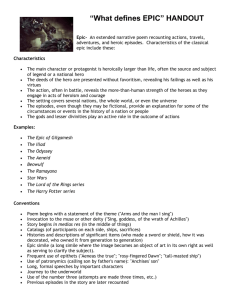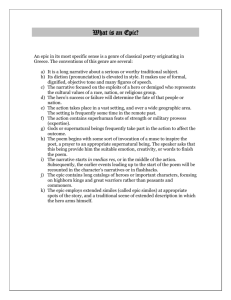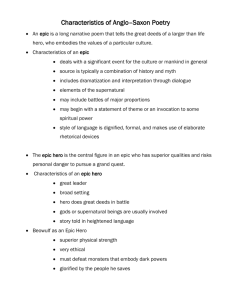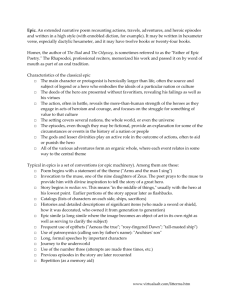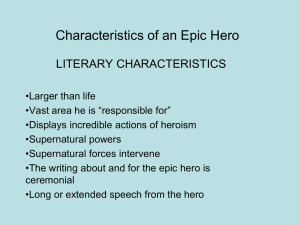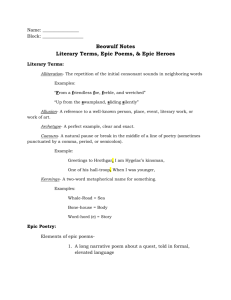Epic Poetry
advertisement
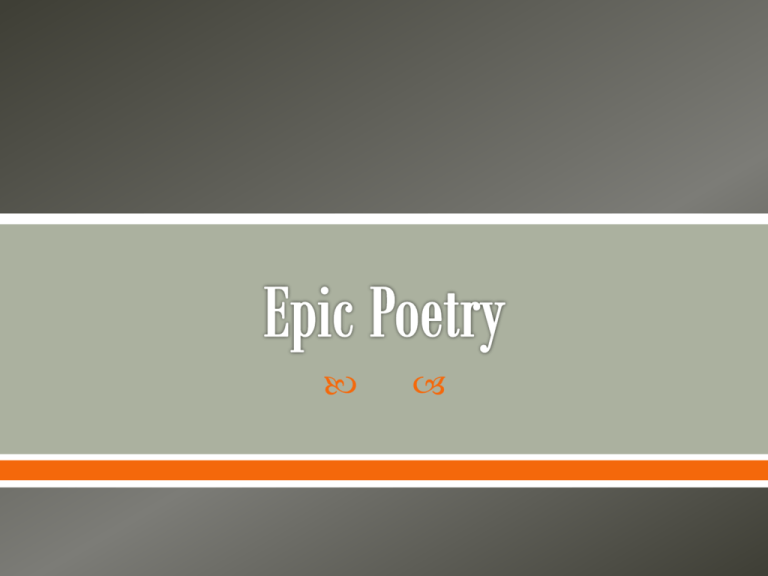
EQs: What is an epic poem, and how does it differ from other kinds of poetry or storytelling? How have epic poems traditionally been transmitted from generation to generation? How do tellers remember these long and complicated stories? Objectives: Define epic poetry and be able to identify and describe the epic hero cycle. Identify elements of epic poetry, including the epic hero cycle, in stories they know already. Describe the way that narrative structures such as the epic hero cycle help bards in the remembering and telling of these immense and complicated works. The main character is a hero, who is often possessed of supernatural abilities or qualities. The hero is charged with a quest. The hero is tested, often to prove the worthiness of himself and his quest. The presence of numerous mythical beings, magical and helpful animals, and human helpers and companions The hero’s travels take him to a supernatural world, often one that normal human beings are barred from entering. The cycle must reach a low point where the hero nearly gives up his quest or appears defeated. A resurrection. Restitution. Often this takes the form of the hero regaining his rightful place on the throne. The Epic of Gilgamesh The Iliad The Odyssey The Aeneid Beowulf The Ramayana Star Wars The Lord of the Rings series The Harry Potter series An epic poem is a long narrative poem that describes the actions and travels of a heroic main character in elevated language and style. Epic poems were composed orally, often to music, for recitation but were not written down until centuries later. Besides length, serious subject matter and composition, epic poems also share specific characteristics and style elements. Invocation of the muse: Epic poems begin with the narrator's statement of the poem's subject and his invocation to, or calling upon, a muse or other divine entity to assist him in taking on the task of telling his story. In medias res: All epic poems have an "in medias res," meaning "in the midst of things," opening. That is, the poem opens in the middle of the story's action, not the beginning. Epic Simile: long, highly descriptive similes that clarify the subject; using like or as. Epithets and Patronymics: Characterizing words or phrases applied to a person or thing and sometimes used in place of their actual name/title. Patronymics, calling a son by his father’s name, is also frequently used. Long Speeches, Histories and Descriptions: the hero and other important characters often make long, formal speeches, such as challenges or points of debate, in the middle of action. Epic poems also contain lengthy histories and descriptions of important items/characters. Gods, other deities and divine places: Usually act to assist the hero or become an obstacle in his quest; whether for good or evil. RHYTHM / METRE – The flow or movement of words, phrases and sound within a line of poetry METRICAL FOOT/UNIT: a group of 2 or 3 syllables forming the basic unit of poetic rhythm o Ex: Iamb, anapest, trochee, spondee, dactyl….all have variations of stressed and unstressed syllables. BLANK VERSE – Verse which is unrhymed but adheres to a regular metrical pattern, usually iambic pentameter where each line consists of ten syllables. FIGURATIVE LANGUAGE - Language is described as figurative when metaphors, similes, or symbols are used. FREE VERSE – A form or arrangement of verse that is very flexible and free from fixed patterns of meter and rhyme. The Iliad is composed in *dactylic hexameter — that is, each line consists of six metrical units (hexameter), the basic metrical unit being the dactyl (a long syllable followed by two short syllables [ ̄ ̌ ̌ ], named after the Greek word for "finger" [extend the index finger of your left hand and you will see why]). Thus the basic pattern of each line in the Iliad is diagrammed as follows (the final ⊗ indicates a syllable that can be either long or short (anceps) — note how the last foot is cut short (syncopation), a device that serves to highlight the end of each line and so distinguish one line from another): ̄̌̌ | ̄̌̌ | ̄̌̌ | ̄̌̌ | ̄̌̌ | ̄⊗ http://www.youtube.com/watch?v=X15BI8xL0W0 You will receive a copy of lyrics First, just listen, then listen and look. Finally, complete a close reading and annotate the poem Determine rhyme scheme
